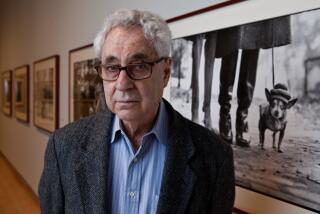Photographer Andre Kertesz Dies at 91 : Accolades Came Late in Life; Three Decades Spent in Obscurity
- Share via
Andre Kertesz, who survived 30 years of obscurity in the United States to, in the twilight of his life, win bittersweet acknowledgement as one of the world’s major photographers, died Saturday in New York.
The Hungarian-born Kertesz was 91 and had been in frail health. Joseph Fernandez, a family friend, said Kertesz died in his sleep at the Greenwich Village home where he had lived for decades.
Kertesz’s glory--and the reason he was for so long underrated--was the simplicity of his subjects. He caught everyday people in the small triumphs of life--commuters trudging doggedly through snow-covered streets, a dancer reclining on a sofa and kicking up her heels, a passer-by touchingly approaching a wounded bird.
Portrayed Cities’ Subtleties
And he portrayed the subtleties of the world’s great cities--their gardens, their shuttered facades, the geometries of their architecture.
“I shoot the little things, what everyone sees and doesn’t see,” he told The Times in August.
Ironically, Kertesz died as his photographs received their most widespread accolades. A highly publicized, one-man exhibition opened at the Chicago Museum in May and is scheduled to move to New York’s Metropolitan Museum of Art in December.
He was born July 2, 1894, into a Budapest family of booksellers and landowners. He flirted with a career in farming, but when he saw his first camera, he was sold. He took his camera along when he served as a soldier in the Austro-Hungarian army in World War I. After the war, hoping to develop professionally, he headed for Paris.
For 11 years, he flourished there, publishing four books of pictures of landmarks and people and finding solace in an artistic community that included painters Pieter Mondrian and Marc Chagall, sculptor Alexander Calder and a swarm of other progressive artists.
War Prevented Return to France
In 1936, a renowned photographer in Paris, he accepted what was to be a yearlong assignment in New York. But when time came to return to France, pre-World War II tensions prevented his departure.
He continued taking his stylized photographs but found no receptive audience. To pay the rent, he was forced to seek commercial assignments for Harpers Bazaar, Vogue and Town and Country magazines.
“He was a kind of casualty of our inability to appreciate his subtlety and humor and great refinement,” critic Hilton Kramer said.
Kertesz recalled that during that dry period, his work was rejected by a Life magazine editor, who told him, “You talk too much with your pictures.”
“This is a mistake!” he shouted, retelling the story decades later. “You should talk with your pictures. I don’t touch the camera without expressing myself. . . .”
Indifference Began to Fade in 1964
The indifference that had greeted Kertesz’s work began to fade in 1964 when he mounted a one-man exhibit at the Museum of Modern Art. Several small galleries presented his works over the years, and his portfolio grew. Even as he grew frail, he photographed New York’s Washington Square from his apartment balcony.
Even in the last year, as the Chicago and New York shows were publicized and his fame mounted, a melancholy Kertesz could not forget the 30 years in which he virtually disappeared. “It is absolutely too late,” he said.
Kertesz’s wife of 44 years, Elizabeth, died in 1977, and family friend Fernandez said the couple had no children.
Funeral services are scheduled for Wednesday in New York.
More to Read
The biggest entertainment stories
Get our big stories about Hollywood, film, television, music, arts, culture and more right in your inbox as soon as they publish.
You may occasionally receive promotional content from the Los Angeles Times.











